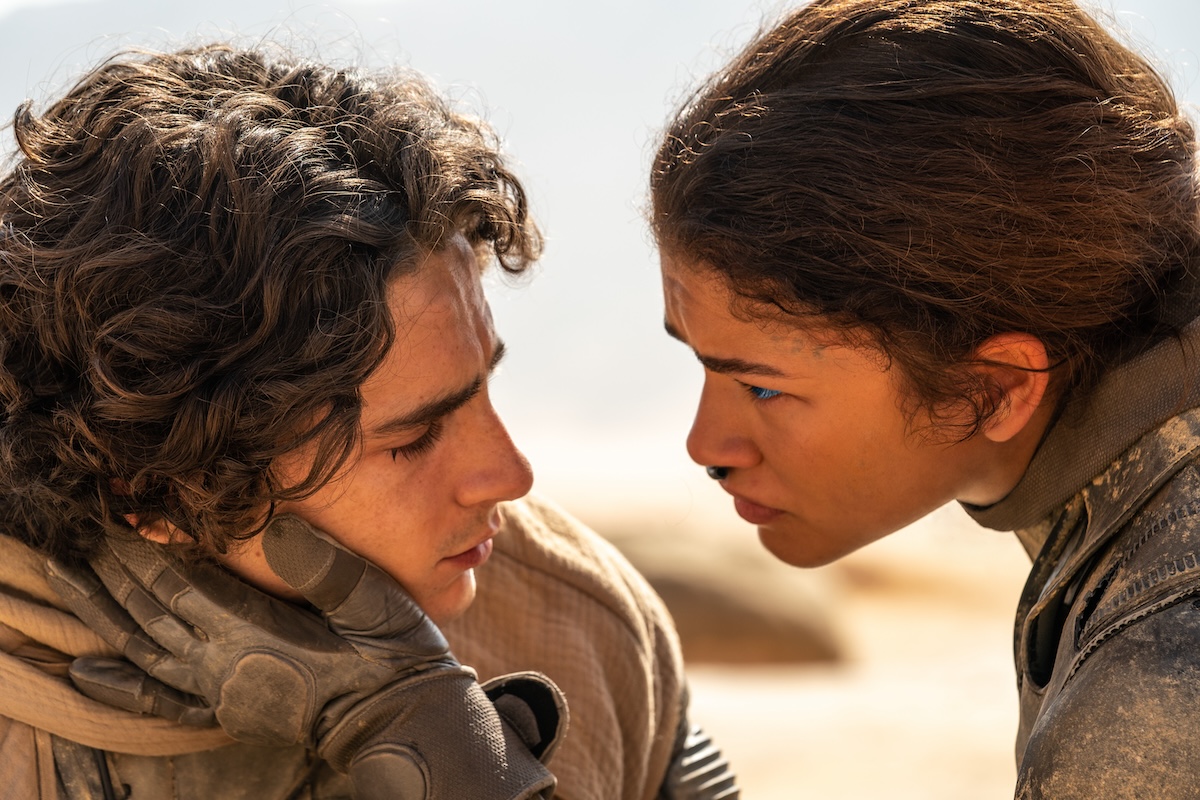The End of ‘Dune: Part Two’ Reveals Paul’s True Nature

Dune: Part Two, based on the second half of Frank Herbert’s 1965 novel, sets the stage for Dune: Part Three and complicates the character of Paul Atreides (Timothée Chalamet). The end of Dune: Part Two weaves together a lot of threads, so let’s pull them apart!
Here’s a breakdown of the end of Dune: Part Two—and what it means for Paul, Chani (Zendaya), and the rest of the characters going forward.
The Fremen defeat the Harkonnens and the Emperor
Dune: Part Two focuses on Paul and the Fremen’s struggle to reclaim control of Arrakis after House Harkonnen destroys House Atreides. In the final act of the film, the Fremen come face to face not just with Baron Harkonnen (Stellan Skarsgård), but with the Emperor (Christopher Walken) himself.
After the Fremen use the sandworms to take out the Emperor’s stronghold, Paul and Feyd-Rautha (Austin Butler) face off in a duel. Although Feyd-Rautha gets in a couple of hits, Paul eventually wins.
That’s where things get really disturbing, really fast.
Paul’s ascension to Mahdi—and his transformation into an anti-hero
When Paul confronts the Emperor, he demands the hand of Princess Irulan (Florence Pugh). The problem, aside from treating Irulan like property? Paul has already pledged his love to Chani.
Indeed, just before the final fight, Paul tells Chani that he’ll always love her—anticipating, no doubt, his eventual plan to marry Irulan. That doesn’t stop Chani from reeling at Paul’s betrayal, though. In one potent scene, Irulan and Chani make eye contact, and Irulan immediately understands what Paul has done.
But that’s not the only unsavory part of Paul’s character that comes out at the end. In Dune: Part One and the first act of Dune: Part Two, Paul doesn’t put much stock in the prophecy that he’s the fabled Mahdi (see also Muad’Dib), the savior of the Fremen. After all, he knows that the Bene Gesserit have been carefully planting messianic legends among the Fremen for years, and Jessica (Rebecca Ferguson) continues their work after she takes over as Arrakis’ Reverend Mother.
By the end, though, Paul is all in on his supposed role as savior. After he drinks the Water of Life, an elixir that grants precognition, he has visions of countless possible future paths. (Incidentally, this precognition is also how Spice enables interstellar navigators to guide their ships across the stars.) Paul has a vision of a bloody war fought in his name, and then announces to the assembled Fremen leaders that he’s the prophet and leader they’ve been waiting for.
After defeating Feyd-Rautha, Paul seizes the Emperor’s throne and commands the Fremen to attack the Houses that are waiting in orbit around Arrakis. It becomes harder and harder to tell what Paul’s motivation is by the end of the film. Is he trying to stop a terrible war, or bring it on? Is he playing a game within a game, or is he drunk on power?
There’s another reason the end of Dune: Part Two is so troubling. It seems to entrench the white savior trope that has plagued Western cinema since its inception. Paul becoming the Fremen’s leader and savior the moment he joins their civilization perpetuates a very old, very harmful stereotype.
However, there’s one crucial element in this version of the story: Chani. Throughout Paul’s ascension, she sees through his rhetoric, even calling him out in front of all the Fremen leaders who have accepted him as Mahdi. At the end of the film, Chani prepares to ride away on a sandworm, having cut ties with Paul and his followers. Will Chani help the Fremen liberate themselves without the interference of an arrogant young foreign duke?
When we spoke to director Denis Villeneuve about Dune: Part Two, he told us that Paul isn’t meant to be seen as heroic. He’s actually an anti-hero. By the end of the film, it seems like Chani is right to leave Paul behind and try to find freedom for her people some other way.
Where is Alia?
In the original novel, Paul’s sister Alia—also known as St. Alia of the Knife—is born before the end of the story. When the film ends, she’s still in utero, although she already has the mind of an adult and can communicate with Jessica telepathically.
We do get one glimpse of Alia (Anya Taylor-Joy), though. In one of Paul’s visions, he finds an ocean on Arrakis, and sees a young woman in a Fremen stillsuit standing on the shore. The young woman turns around, revealing her identity, and Alia seems to communicate with her older brother through time and space.
So. No unsettling dubbed toddler in Dune: Part Two, but it looks like we’ll get a proper introduction to Alia in Part Three.
In the meantime, let’s hope Chani finds a way to bring real liberation to the Fremen, and a brighter future to Arrakis.
(featured image: Warner Bros.)
Have a tip we should know? [email protected]
